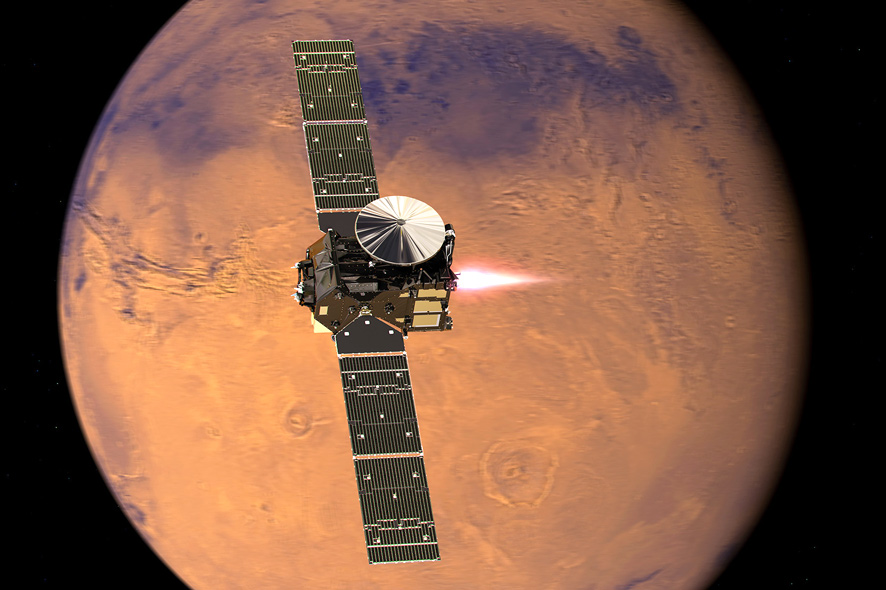Mark McCaughrean is seated in his office before a computer screen and a scale model of the 67P/C–G comet, turning and rotating it and explaining to a fascinated layman—without thereby drifting off into complex scientific jargon—why and how his team intends to land a space probe (that actually wasn’t even built to do the job) on precisely this comet. Mark McCaughrean, senior science advisor in the ESA’s Directorate of Science, took some time out from his busy schedule to elaborate on the upcoming missions in a clear and easily understandable manner. One of his main talking points in the first part of the interview is the European Space Research and Technology Center in The Netherlands where, under the aegis of the European Digital Art and Science Network, an artist will have the opportunity to spend a residency before proceeding on to the Ars Electronica Futurelab. Sound interesting? You still have until June 20, 2016 to apply at ars.electronica.art/artandscience!

The ESTEC in The Netherlands, Credit: ESA-Anneke Le Floc’h
The “art&science@ESA” residency will be hosted at ESTEC, the technical heart of ESA. What facilities and rooms are there in Noordwijk and what possibilities will the artists have at the European Space Research and Technology Centre?
Mark McCaughrean: ESTEC is the heart of all the technical things we do at the European Space Agency. It’s the biggest centre of ESA. We have many other facilities in other countries across Europe in Germany, France, Italy, Spain, the United Kingdom, and overseas including our Kourou launch site in French Guiana. But Noordwijk is the biggest centre by a long way and it is where much of the technology development and testing happens.
The project engineering for the satellites that we build happens here, and we have the so-called project scientists for our space science missions at ESTEC as well. Their job is to ensure that the satellites are able to deliver the science they’re built for.
After being built in European industry, many of our satellites will come here to ESTEC to be checked out in our large test facilities. These include acoustic chambers and vibration tables to simulate the forces experienced during launch, and huge cryogenic chamber to simulate space. You pump out all of the air to create a vacuum and then illuminate the spacecraft on one side with very bright lights and an enormous mirror to simulate sunlight. We can make it ten times brighter than normal sunlight, for example, as if we were at Mercury: this is where our BepiColombo mission is going. On the other side, the walls of the chamber are cooled to around minus 170 degrees Celsius to complete the picture. At 15 metres high and 10 metres in diameter, it’s the biggest chamber of its kind in Europe.
Then the satellites go from here to Kourou in South America, where they get launched into space on an Ariane 5, Soyuz, or Vega. Or they may go to other launch sites such as Baikonur in Kazakhstan and launched on Russian rockets.
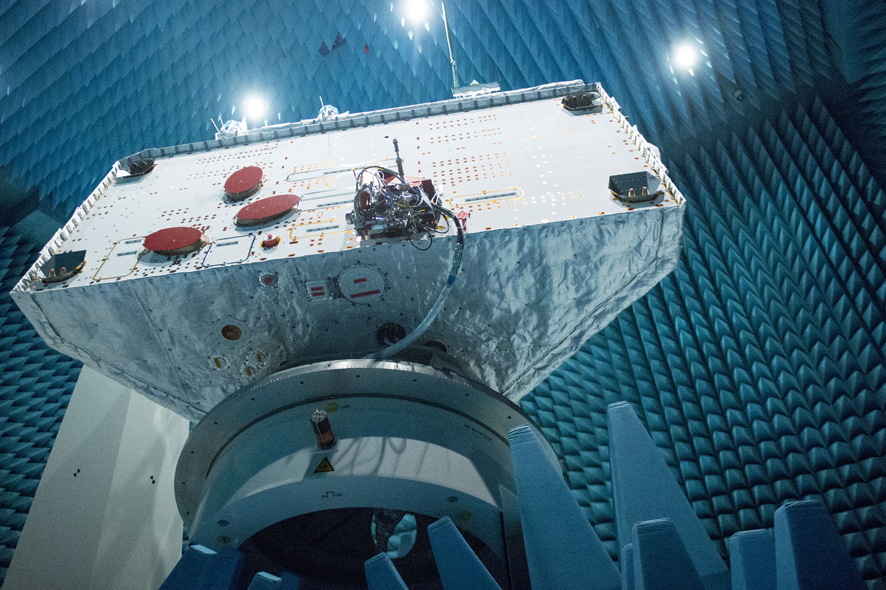
Tests for the BepiColombo mission, Credit: ESA–G. Porter, CC BY-SA 3.0 IGO
So, a lot happens at ESTEC, and the artist that would come here will get a tour around the site, to look at some of the spacecraft in the test chambers, and to visit our onsite exhibition centre that includes some spacecraft that have been into space and came back, including test capsules and other space hardware. And she or he would of course have access to the people that are here – to talk to the scientists, engineers, and other staff about how ESA’s exciting missions are put together and run.

The Comet 67P/C-G. Credit: ESA/Rosetta/MPS for OSIRIS Team MPS/UPD/LAM/IAA/SSO/INTA/UPM/DASP/IDA
You are closely involved in the Rosetta mission. In September 2016, the spacecraft will touch down on Comet 67P/Churyumov–Gerasimenko. What’s the strategy behind this manoeuvre?
Mark McCaughrean: Rosetta was launched in 2004 and travelled for ten years through the solar system. This included flying past the Earth three times and Mars once to borrow some of their energy and get onto the same orbit as the comet. But between mid-2011 and early 2014, Rosetta was out towards the orbit of Jupiter and there wasn’t enough sunlight and power to run the spacecraft safely. So we put it into hibernation, turning it all off except for some heaters to keep the fuel from freezing and a kind of alarm clock to wake it up at the right moment, as it started coming closer to the Sun again.
This all worked and Rosetta woke up on 20 January 2014. It rendezvoused with the comet in August and has been flying alongside it ever since, doing wonderful science, including of course putting the small lander Philae on the surface in November 2014.
But now the comet and Rosetta are travelling away from the Sun again, and the Rosetta team had a decision to make. You might think we’d just go back into hibernation for another 2.5 years, wait until we move back towards the Sun, and start again. But in fact, there is not enough fuel left on board to do much more science. You have to keep in mind that we don’t just orbit around the comet in orbit. It’s not very big and it doesn’t have much gravity, so we actually use propellant to fly around it.

Rosetta (left) and Philae (middle) next to the comet. Credit: ESA/ATG medialab; Comet image: ESA/Rosetta/Navcam
Even if we did have fuel and managed to wake Rosetta up again, it’s an ageing spacecraft by now, having sat next to a dusty comet for nearly two years. It’s not the same satellite that got there in 2014, it’s getting old, and some of the systems are getting past their prime lifetimes. You probably wouldn’t be able to do much more science.
“Another choice would be to just turn it off and let it drift away. But that makes no sense. Instead, we’ve decided to end the mission by descending slowly down to the surface of the comet and make a controlled impact. We hope to do science all the way down to the surface with the instruments: we should be able to see and analyse the surface and material coming off it in much more detail than has been possible before.”
But it’s important to realise that Rosetta was not designed to land and very probably will not survive. It doesn’t have the legs and damping systems of the Philae lander; it has huge fragile solar panel wings; and it has a big dish to talk to the Earth, receiving commands and returning the data.
Even if it did miraculously survive the landing in a perfectly upright and stable position, it would be on a comet that’s rotating every 12.4 hours. Very soon, the big dish would no longer be pointing at Earth and we’d lose contact.
So we’re planning on getting great science done on the way down, but are very sure it won’t survive. At the moment, the teams are picking the place they want to aim for and then trying to work out how to get there: it’s not so easy landing on an irregular rotating comet. There’s a lot of work still to do, but it looks like we’ll be shooting for the end of September. It’ll be a big day for everyone involved; emotional about the mission ending, but happy with all its great achievements.
The ExoMars missions are aimed at the search for life on Mars. You launched the ExoMars 2016 mission in March, and in October, the Schiaparelli EDM lander will reach the surface of Mars. What would that mean for humanity if the missions found evidence for past or present life there?
Mark McCaughrean: This is a deep philosophical question, perhaps one of the fundamental ones. Are we alone? Did life arise just once? Or is it commonplace in the Universe? There are many billions of stars in our galaxy and many billions of galaxies in the Universe, and in the past twenty-five years we’ve shown that most stars have planets. Thus many of us hold it as axiomatic that there must be life elsewhere, but finding evidence for that would be very profound indeed.
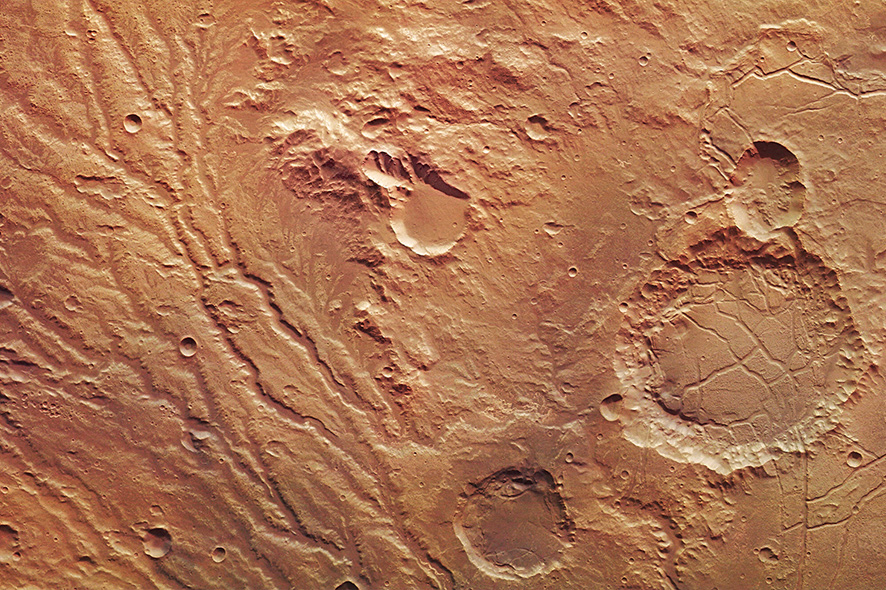
The surface of Mars. Credit: ESA/DLR/FU Berlin, CC BY-SA 3.0 IGO
Beyond the Earth, Mars seems like the most obvious place to look for life in the solar system. There’s a whole battery of evidence for it having had extensive liquid water on the surface in the past, billions of years ago, when it was warmer: there are dried up lakes and sea-beds, giant valleys, and drainage channels. We see water ice at the poles, and we also know from images and radar measurements that there’s a lot of ice just under the surface in many places. So it seems like there’s a good chance that primitive life may have formed on the young Mars, just as it did on the Earth. Whether or not it did and whether or not it’s still there, well, that’s why we’re looking.
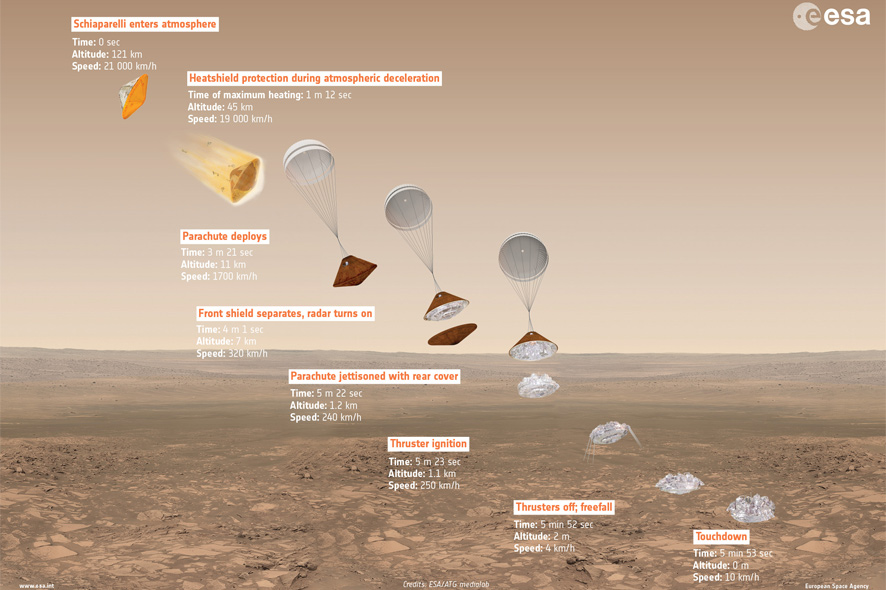
The ExoMars 2016 mission. Credit: ESA/ATG medialab
ExoMars is a joint programme with the Russians and involves two missions. One of the key things the mission en-route there now is going to study trace gases in the martian atmosphere, in particular methane. We know there’s a small amount there thanks to measurements by our Mars Express satellite, but we don’t know where it’s coming from. It could be coming from geological processes deep under the surface, or more excitingly, it could be coming from primitive life forms like the ancient methanogens on Earth that produce much of our methane. The ExoMars 2016 Trace Gas Orbiter should help us figure this out.
Then in 2020, our second ExoMars mission will have a rover that can drive around the surface examining things in detail. Uniquely, it will be able to drill two metres under the surface to look for evidence of life, past of present, sheltering away from the dangerous cosmic radiation that hits the planet.
But there’s one funny thing to consider. Earth and Mars are connected by a kind of bridge through space, a bridge made out of meteorites. When an asteroid or a comet hits a planet, a lot of debris is thrown into space, and not all of it comes back down again. After floating through space for millions of years, it may end up hitting another planet, and indeed, we have a small number of meteorites on the Earth that we believe came from Mars, based on their chemical characteristics. Similarly, there must be Earth rocks on Mars.
Through a speculative mechanism called “lithopanspermia”, very primitive life could conceivably be exchanged between the planets via this bridge. But what’s interesting is that Mars is smaller than Earth and has less gravity. So it’s actually easier to get things off Mars than it is from the Earth. In a weird way then, we could actually be Martians: life might have started there and been transported here.
“So, if we find life on Mars, it’ll be a major scientific breakthrough and absolutely fascinating. But there’s at least a possibility that it might turn out to be similar to life on Earth, and that it started in one place and travelled to the other. That would then leave the fundamental question unanswered: has life started twice, independently, in the Universe?”
For this reason, there’s a great deal of interest in looking elsewhere for life too. For example, we know that there are giant water oceans under the icy crusts of some of the giant moons of Jupiter and Saturn. But those crusts are many, many kilometres thick, there’s no way that life carried by meteorites from Earth or Mars could get into the oceans, so any life there would have to have arisen independently.
The other intriguing place is Titan one of Saturn’s moons. It has a dense atmosphere, and at the surface there are lakes, rivers, and rain storms. But there’s no water involved; it’s much too cold. It’s all about liquid hydrocarbons, methane and ethane. So if some form of life has arisen in that liquid environment, then it must be completely different to the life of the Earth. Finding life on Titan would give an unequivocal answer the question of whether life formed twice, and would imply that it has likely formed a hundred times or a billion times in the Universe.
So after Rosetta and ExoMars, what are ESA’s next big science missions?
Mark McCaughrean: We’re currently operating a whole series of missions, including Gaia, LISA Pathfinder, Mars Express, Cluster, INTEGRAL, XMM-Newton, SOHO and others with our various partners, returning great astronomy and solar system science.
And we have a whole range of new missions coming up. In two years time, we’re launching a mission called bepiColombo to Mercury, the closest planet to the Sun. It’s a very strange small world, very hot because it’s close to the Sun. But some parts of it near the poles never see the Sun and there is actually ice there, which is odd: it probably arrived fairly recently via impacts.
There are some other odd things about Mercury. For example, it was found to have a magnetic field about 1% the strength of Earth’s, but this was unexpected, as Mercury was thought to be too small to still have a liquid metal core like Earth’s, the origin of our magnetic field. Venus and Mars are bigger than Mercury, and yet they only have very weak magnetic fields at best. Given how important the Earth’s magnetic field is to protecting life here, understanding the diversity of the fields found on the various planets is important, and investigating Mercury’s is a key goal of BepiColombo.
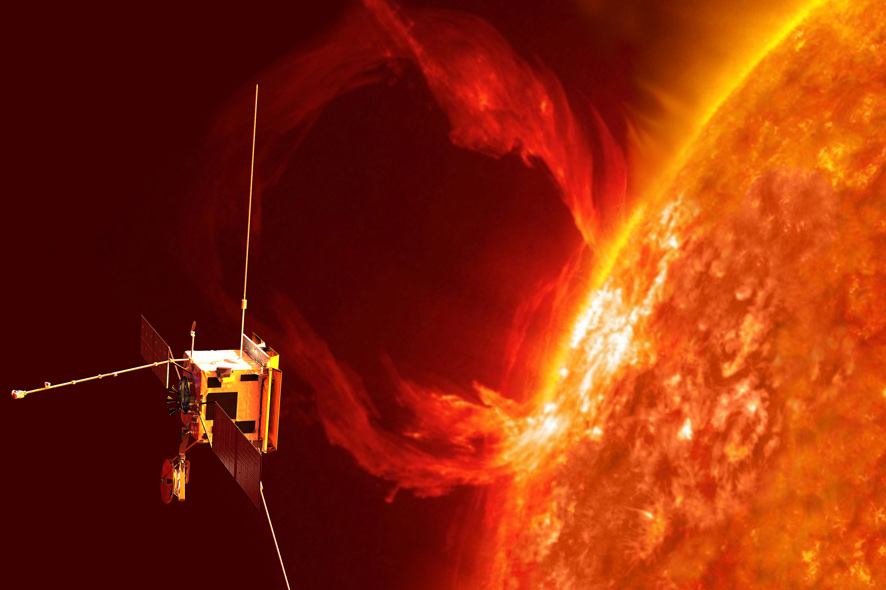
The Solar Orbiter will start in 2018. Credit: ESA/AOES
We have another mission going close to the Sun, but this time to study the Sun and the solar wind directly: it’s called Solar Orbiter and will launch in 2018. The Earth is 150 million kilometres away from the Sun, but Solar Orbiter will go in to around 42 million kilometres away and look more closely. We’ll be able to get much more detailed images and measure the wind flowing away from the Sun while it’s still fairly smooth. By travelling rapidly around the Sun on fly-bys, we’ll be able to follow features moving around the Sun for longer than is possible from Earth, and we’ll also slowly move up to higher and higher latitudes, to look down on the Sun and study its poles.
Then we have several new astronomy missions coming up. We are partners with NASA and the Canadian Space Agency in the James Webb Space Telescope – it’s the biggest telescope ever built to fly in space. With a primary mirror 6.5 meters across, it’s huge, much bigger than the Hubble Space Telescope. That’s now being assembled and tested in the US; we have two scientific instruments on board and it will fly on a European Ariane 5 rocket from Kourou in 2018. We’re building a mission called CHEOPS to study planets orbiting other stars, one called Euclid to investigate dark matter and dark energy, and further out, a big X-ray telescope to observe the high-energy universe, and a gravitational wave observatory to study things like the mergers of supermassive black holes. We have a huge long list of interesting things we’ll be building over next 20 years.

Infrared photo of the NGC 2174. Credit: NASA/ESA and the Hubble Heritage Team (STScI/AURA)
The Ars Electronica Blog will publish Part 2 of this extensive interview with Mark McCaughrean in the coming days. In the next installment, the focus is on art and science, and, above all, the role that art can play when it comes to comprehending the universe. But will humankind ever even have the wherewithal to comprehend all this? Are the distant galaxies really as colorful as they are in the pictures that we see? The second part of this interview will go into these questions and many other fascinating aspects of our universe. Come along for the ride!
And don’t forget—you still have until June 20, 2016 to apply for a residency at the ESA and at the Ars Electronica Futurelab. To get the details and submit an application, go to ars.electronica.art/artandscience!

Prof Mark McCaughrean works for the European Space Agency, where he is the Senior Scientific Advisor in the Directorate of Science, responsible for communicating the scientific results from ESA’s astronomy, heliophysics, planetary, and fundamental physics missions. Following his PhD from the University of Edinburgh in 1988, he has worked in the UK, the US, Germany, and the Netherlands. His personal research involves observational studies of the formation of stars and their planetary systems using state-of-the-art ground- and space-based telescopes. He is an Interdisciplinary Scientist on the Science Working Group for the NASA/ESA/CSA James Webb Space Telescope.
